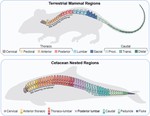Back2Sea
Axial evolution in secondarily aquatic mammals

Unravelling adaptations and evolutionary impacts of major ecological transitions remains a central theme in evolutionary biology.
Secondary invasions of the aquatic realm by land-dwelling tetrapods are one such example, involving a shift from limb-based to axial-driven locomotion and accompanying reorganization of the postcranial skeleton. Modifications of limbs to flippers are well documented, yet, adaptations of the backbone associated with these transitions remain poorly understood.
Mammals have reinvaded water numerous times, using a variety of swimming modes, and thus provide an ideal system for studying axial evolution in land-to-water transitions. The Back2Sea project will investigate the impact of the secondary invasion of the aquatic realm on the mammalian backbone by examining: vertebral morphology and function, backbone regionalisation and modularity, and mode and tempo of axial evolution.
To achieve this, Back2Sea quantifies form and function at the organismic scale using biomechanical experimentation, and combine this with data on macroevolutionary patterns of vertebral morphology across a wide variety of terrestrial, aquatic, and semiaquatic extant and fossil mammals.
Analyses conducted in a broad phylogenetic and quantitative evolutionary context allow to address fundamental questions about the patterns and processes driving land-to-water transitions.
